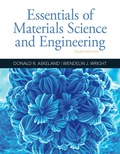
(a)
Interpretation:
The microstructure present in
Concept Introduction:
Heat treatment is a process used to change the material's physical and chemical properties. Metallurgical is the most frequent applications. Heat treatment is used in the production of many products such as glass. Heat treatment includes heating or cooling to achieve the required outcome, usually at extreme temperatures.
Answer to Problem 13.14P
The microstructure that is present after going through the various processes, is ferrite and pearlite.
Explanation of Solution
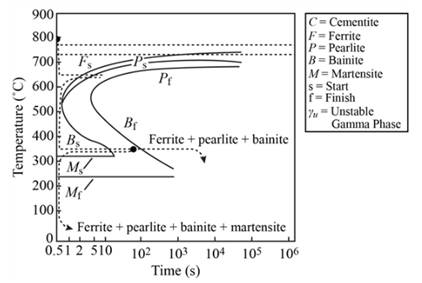
When
(b)
Interpretation:
The microstructure present in steel heated at
Concept Introduction:
Heat treatment is a process used to change the material'sphysical and chemical properties. Metallurgical is the most frequent applications. Heat treatment is used in the production of many products such as glass. Heat treatment includes heating or cooling to achieve the required outcome, usually at extreme temperatures.
Answer to Problem 13.14P
Bainite remains as microstructure after going through the heating and quenching process.
Explanation of Solution
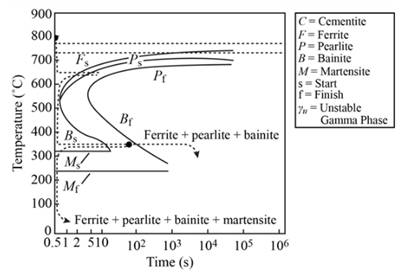
When
Thus, bainite microstructure remains after going through heating and quenching.
(c)
Interpretation:
The microstructure present in steel after being heated at
Concept Introduction:
Heat treatment is a process used to change the material's physical and chemical properties. Metallurgical is the most frequent applications. Heat treatment is used in the production of many products such as glass. Heat treatment includes heating or cooling to achieve the required outcome, usually at extreme temperatures.
Answer to Problem 13.14P
Martensite remains as microstructure after heated at
Explanation of Solution
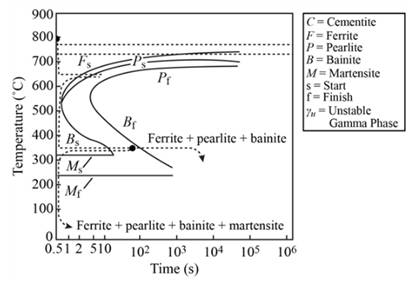
When
(d)
Interpretation:
The microstructure present in
Concept Introduction:
Heat treatment is a process used to change the materials physical and chemical properties. Metallurgical is the most frequent applications. Heat treatment is used in the production of many other products such as glass. Heat treatment includes heating or cooling to achieve the required outcome, usually at extreme temperatures.
Answer to Problem 13.14P
Ferrite and martensite remain as microstructure after heated at
Explanation of Solution
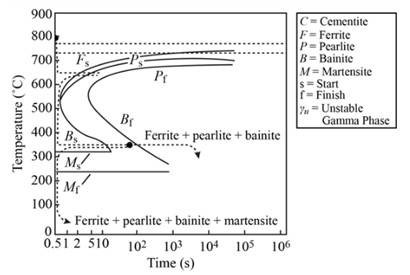
When
(e)
Interpretation:
The microstructure present in
Concept Introduction:
Heat treatment is a process used to change the material's physical and chemical properties. Metallurgical is the most frequent applications. Heat treatment is used in the production of many products such as glass. Heat treatment includes heating or cooling to achieve the required outcome, usually at extreme temperatures.
Answer to Problem 13.14P
Ferrite and bainite remain as microstructure.
Explanation of Solution
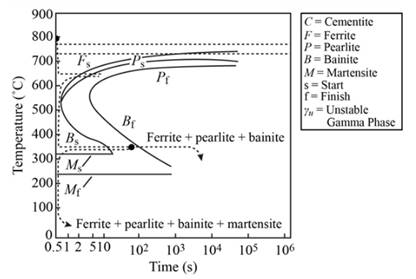
When the
(f)
Interpretation:
The microstructure present in
Concept Introduction:
Heat treatment is a process used to change the material's physical and chemical properties. Metallurgical is the most frequent applications. Heat treatment is used in the production of many products such as glass. Heat treatment includes heating or cooling to achieve the required outcome, usually at extreme temperatures.
Answer to Problem 13.14P
Ferrite, bainite, and martensite remain as microstructure.
Explanation of Solution
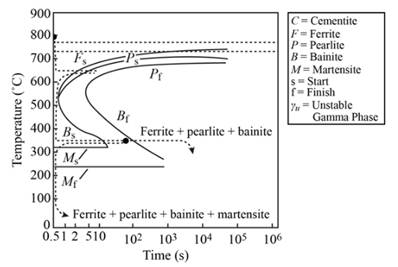
When
(g)
Interpretation:
The microstructure in
Concept Introduction:
Heat treatment is a process used to change the material's physical and chemical properties. Metallurgical is the most frequent applications. Heat treatment is used in the production of many products such as glass. Heat treatment includes heating or cooling to achieve the required outcome, usually at extreme temperatures.
Answer to Problem 13.14P
Tempered martensite is the only microstructures that remain in
Explanation of Solution
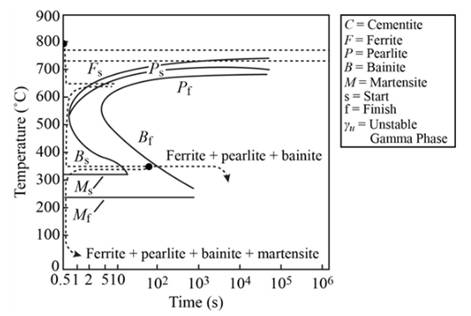
When
Want to see more full solutions like this?
Chapter 13 Solutions
Essentials Of Materials Science And Engineering
- A. Using D flip-flops, design a logic circuit for the finite-state machine described by the state assigned table in Fig. 1. Present Next State State Output x=0 x=1 Y2Y1 Y2Y1 YY Z 00 00 01 0 01 10 11 888 00 10 0 00 10 1 00 10 1 Fig. 1arrow_forwardList all inaccurate or unsupported factual claimsarrow_forwardWhen using a work breakdown structure (WBS) for a project why it is necessary to break down activities?arrow_forward
- Select the speed, feed and depth of the cut to turn wrought, low carbon steel (hardness of 200 BHN) on lathe with AISI tool material of HSS M2 or M3. (Hint: refer to Chapter 21 for recommended parameters).arrow_forwardGiven the following request to an Al chatbot, which Al chatbot produces a better response? Request Write a casual email to my colleague Jamie letting her know I can't make the 2pm meeting and asking to reschedule. Make the body of the email 3 sentences, the second word of the second sentence should start with Y, and the entire email (including the greeting and signature) should be no more than 27 words. Chatbot #1 Hi Jamie, Apologies, I can't attend the 2pm meeting. Would you mind rescheduling? Looking forward to it. Thanks. [Your Name] Chatbot #2 Dear Jamie, I'm sorry, but I can't attend the 3pm meeting. Would you mind rescheduling? Regards, [Your Name] Chatbot #1 is a better response ○ Chatbot # 2 is a better response Please explain your answer in 2-3+ sentences. (The more insightful and well-reasoned explanation you write, the better, since we prioritize high-quality writing.)arrow_forwardAs shown in the figure below, a 1.5 m × 1.5 m footing is carrying a 400 kN load. P Depth (m) 0.0 1.0 2.0 Df Groundwater table (Yw = 9.81 kN/m³) 3.5 Yt = 16.5 kN/m³ E = 9,000 kPa Sandy soil Ysat 17.5 kN/m³ E = 15,000 kPa 6.0 Stiff Clay (OCR = 2) Bedrock Ysat 18.0 kN/m³ eo = 0.8 Cc = 0.15, Cr = 0.02 Eu =40,000 kPa (a) Estimate the immediate settlement beneath the center of the footing. Assuming that Poisson's ratios of sand and soft clay are 0.3 and 0.5, respectively. Use numerical integration approach. For the calculations, use layers (below the bottom of the footing) of thicknesses: 1 m; 1.5 m, and 2.5 m. (b) Determine the primary consolidation settlement beneath the center of the footing. (c) Redo Part (b) if OCR=1.1. Note: Use the 2:1 method to determine the stress increase below the footing. For parts (b) and (c), use the one-dimensional consolidation theory.arrow_forward
- Consider the cross-sections illustrated in the next slides. Implement a cross-sectional analysis based on a layered discretisation of the cross- section as required at the following. 1) Develop the implementation of an analysis to estimate the nonlinear response of the composite steel-concrete section, of the reinforced concrete section and of the steel section shown in following slides (using material nonlinear models provided in the support files). Provide the details of the numerical implementation with clear explanations of all steps. Hint: the implementation can be done in Excel. 2) Discuss how the 3 cross-sections (shown in the next slides) compare to each other in terms of embodied carbon under the condition that the cross-sections possess the same nominal moment capacity (i.e. the peak moment achieved in the moment-curvature diagram). The discussion should include at least 2 sets of the sections (each set contains one composite section, one reinforced concrete section and one…arrow_forwardAthree phase a.c. distributor AB has: A B C The distance from A to B is 500 m. The distance from A to C is 800 m. The impedance of each section is (6+j 8) /km. The voltage at the far end is maintained at 250 volt. Find: sending voltage, sending current, supply power factor and 80A 60 A total voltage drop. 0.8 lag. P.f 0.6 lead. p.farrow_forwardengineering electromagnetics Subjectarrow_forward
- a ADI ADI b Co ADDS D Fig.(2) 2-For resistive load, measure le output voltage by using oscilloscope; then sketch this wave. 3- Measure the average values ::f V₁ and IL: 4- Repeat steps 2 & 3 but for PL load.arrow_forwardDetermine the type of media In a certain medium with µ = o, & = 40 H = 12ely sin(x x 10% - By) a, A/m A plane wave propagating through a medium with ɛ, = 8, μ, = 2 has E = 0.5 3sin(10°t - Bz) a, V/m. Determine In a certain medium - E = 10 cos (2 x 10't ẞx)(a, + a.) V/m If μ == 50μo, & = 2ɛ, and o = 0, In a medium, -0.05x E=16e sin (2 x 10% -2x) a₂ V/marrow_forward"How can I know if it's lossless or lossy? Is there an easy way?" A plane wave propagating through a medium with &,,-8 μr = 2 nas: E = 0.5 ej0.33z sin (10' t - ẞz) ax V/m. A plane wave in non- · (Mr=1) has: magnetic medium E. 50 sin (10st + 27 ) ay v/m =arrow_forward
 MATLAB: An Introduction with ApplicationsEngineeringISBN:9781119256830Author:Amos GilatPublisher:John Wiley & Sons Inc
MATLAB: An Introduction with ApplicationsEngineeringISBN:9781119256830Author:Amos GilatPublisher:John Wiley & Sons Inc Essentials Of Materials Science And EngineeringEngineeringISBN:9781337385497Author:WRIGHT, Wendelin J.Publisher:Cengage,
Essentials Of Materials Science And EngineeringEngineeringISBN:9781337385497Author:WRIGHT, Wendelin J.Publisher:Cengage, Industrial Motor ControlEngineeringISBN:9781133691808Author:Stephen HermanPublisher:Cengage Learning
Industrial Motor ControlEngineeringISBN:9781133691808Author:Stephen HermanPublisher:Cengage Learning Basics Of Engineering EconomyEngineeringISBN:9780073376356Author:Leland Blank, Anthony TarquinPublisher:MCGRAW-HILL HIGHER EDUCATION
Basics Of Engineering EconomyEngineeringISBN:9780073376356Author:Leland Blank, Anthony TarquinPublisher:MCGRAW-HILL HIGHER EDUCATION Structural Steel Design (6th Edition)EngineeringISBN:9780134589657Author:Jack C. McCormac, Stephen F. CsernakPublisher:PEARSON
Structural Steel Design (6th Edition)EngineeringISBN:9780134589657Author:Jack C. McCormac, Stephen F. CsernakPublisher:PEARSON Fundamentals of Materials Science and Engineering...EngineeringISBN:9781119175483Author:William D. Callister Jr., David G. RethwischPublisher:WILEY
Fundamentals of Materials Science and Engineering...EngineeringISBN:9781119175483Author:William D. Callister Jr., David G. RethwischPublisher:WILEY





